Smartphone design has come a long way since Apple unveiled its first iPhone in 2007. Android phones used to have thick bezels and tiny displays; now they’re so massive they blur the line between tablet and phone. Each year, new advancements in smartphone design and display technology give OEMs the ability to trim down bezels even more. Until the mass production of under-display camera tech next year, though, most OEMs won’t offer truly full-screen smartphones, instead opting to cut a hole or notch in the display to leave room for the front-facing camera(s). A stop-gap solution to this problem has already been in use since last year, though—hiding the camera in the top (pop-up camera) or flipping it around from the back (flip camera). The new ASUS ZenFone 7 Pro is one such device that employs a “Flip Camera” module to offer a full-screen display experience, and it definitely stands out in a year dominated by phones with notches or hole-punches.
ASUS ZenFone 7 Forums ||| ASUS ZenFone 7 Pro Forums
I’ve been using the new ASUS flagship smartphone as my daily driver for a few weeks now, and I’ve been pleasantly surprised by how vastly improved it is over last year’s ZenFone 6. On paper, the ASUS ZenFone 7 Pro doesn’t seem to offer many enhancements over last year’s model, with the newer model packing a newer chipset with 5G support, a third camera, a higher refresh rate OLED panel, and faster charging, while dropping the 3.5mm audio jack and jacking up the price by €200. But in my time using the new phone, I have found little fault with it, and in fact, see that it offers a lot of value over comparably priced flagship smartphones. ASUS used a 2019 design to make a killer 2020 flagship in the ZenFone 7 Pro. Here’s how.
ASUS ZenFone 7 Series Specifications. Tap/click to expand.
| Specification | ASUS ZenFone 7 (ZS670KS) / ZenFone 7 Pro (ZS671KS) |
|---|---|
| Dimensions & Weight |
|
| Design & Build |
|
| Display |
|
| CPU & GPU |
|
| RAM & Storage |
|
| Battery & Charging |
|
| Security | Side-mounted fingerprint sensor (0.3s unlock, supports 5 fingerprints), integrated Smart Key
Software-based facial recognition |
| Cameras | Photo:
Video:
Other Modes & Features:
|
| Audio | Stereo, dynamic, 5-magnet speakers with dual smart amplifiers (NXP TFA9874 smart amplifier)
Triple microphones with ASUS noise reduction technology |
| Ports | USB Type-C, no DisplayPort Alternate Mode/video output
No 3.5mm audio jack |
| Connectivity |
|
| Software | Android 10 with ZenUI 7 |
| Colors | Aurora Black, Pastel White |
| In-the-box |
|
About this review: I received the ZenFone 7 Pro from ASUS on August 17, 2020. The device received one update before launch and is currently running software version WW_29.11.41.19 with the July 5th Android Security Patch Level. ASUS did not have any inputs regarding the content of this review.
ASUS ZenFone 7 Pro: Design
With no notch or hole-punch impeding the viewing area, the ZenFone 7 Pro has what ASUS calls an “all-screen NanoEdge display.” The display measures 6.67-inches diagonally and has rounded corners but does not curve around the edges. The screen-to-body ratio is 92%, which is the same as the ZenFone 6 which has a smaller 6.4-inch display; the ZenFone 7 is thus slightly taller than the ZenFone 6 (165.0mm versus 159.1mm) but has thinner bottom bezels to compensate. The ZenFone 7 Pro is definitely a tall smartphone, with a height similar to the OPPO Find X2 Pro, OnePlus 8 Pro, and Samsung Galaxy S20 Ultra. It just barely fits in my Razer Kishi gaming controller, for example. Because of the 20:9 aspect ratio and 77.28mm width, the ASUS ZenFone 7 Pro is hard to manage in one hand, though ASUS has a few software tricks to make up for that.
What ASUS can’t compensate for in software, though, are the weight and thickness of the phone. At 9.6mm in depth and 230g in weight, the ASUS ZenFone 7 Pro is thick and heavy. It’s barely thinner and lighter than the massive ASUS ROG Phone 3 which measures 9.85mm in depth and 240g in weight. This is the biggest compromise with the Flip Camera design—the module takes up a lot of internal space, thus increasing how thick the phone has to be. Likewise, the heaviness can be attributed to the materials used for the Flip Camera housing, which add weight on top of the phone’s other build materials and large battery. If you’re accustomed to using larger and heavier smartphones, then the ZenFone 7 Pro probably won’t bother you. If you’re upgrading from a much smaller smartphone, though, it could be uncomfortably large and heavy.
The weight and thickness aside, the ASUS ZenFone 7 Pro is a beautifully designed smartphone.
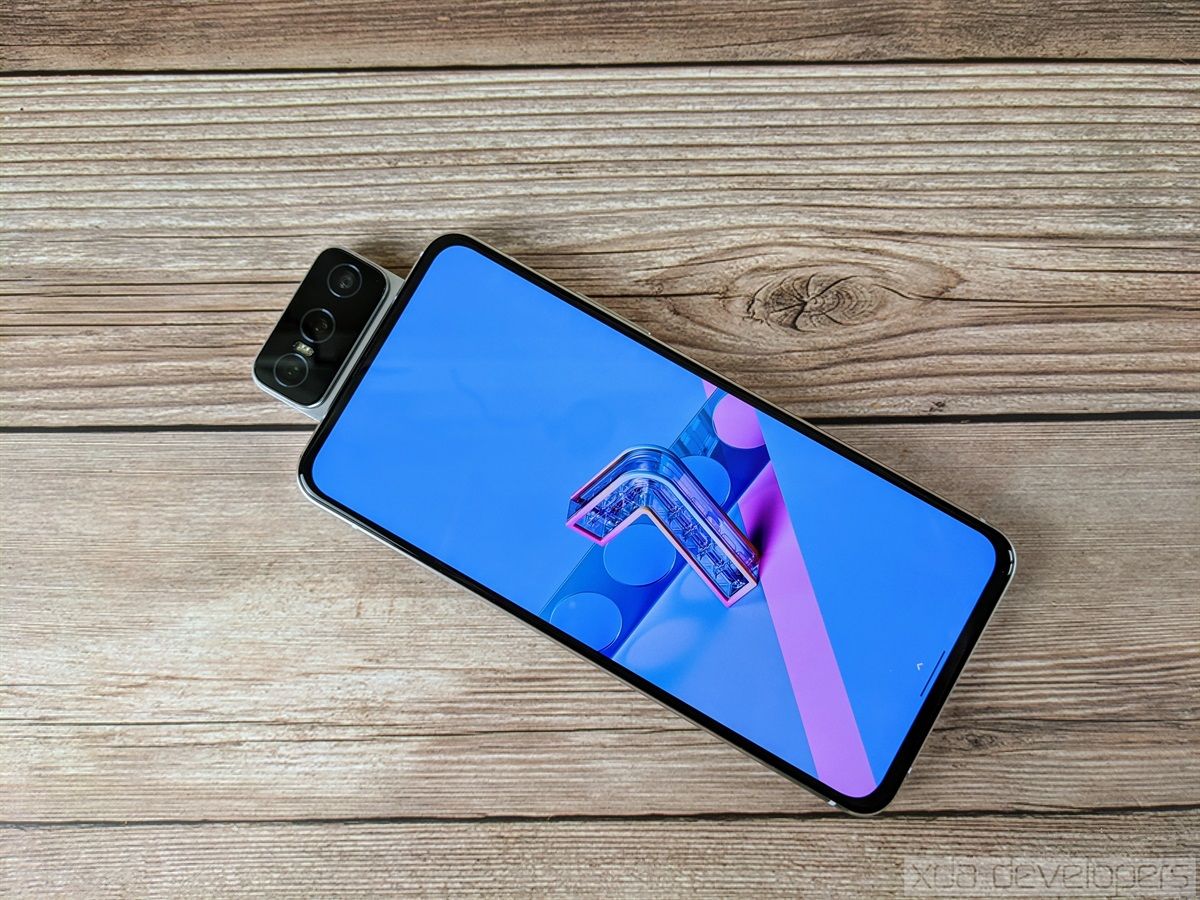
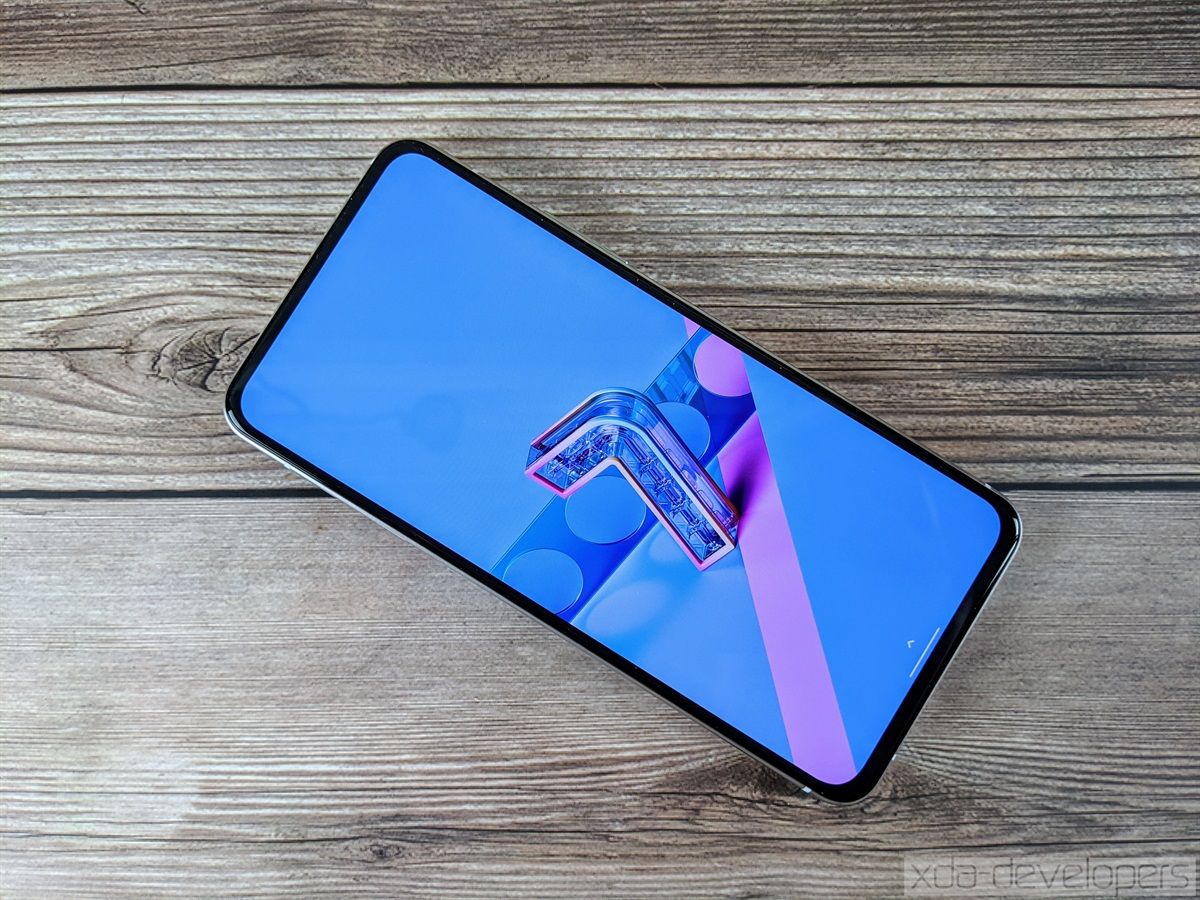
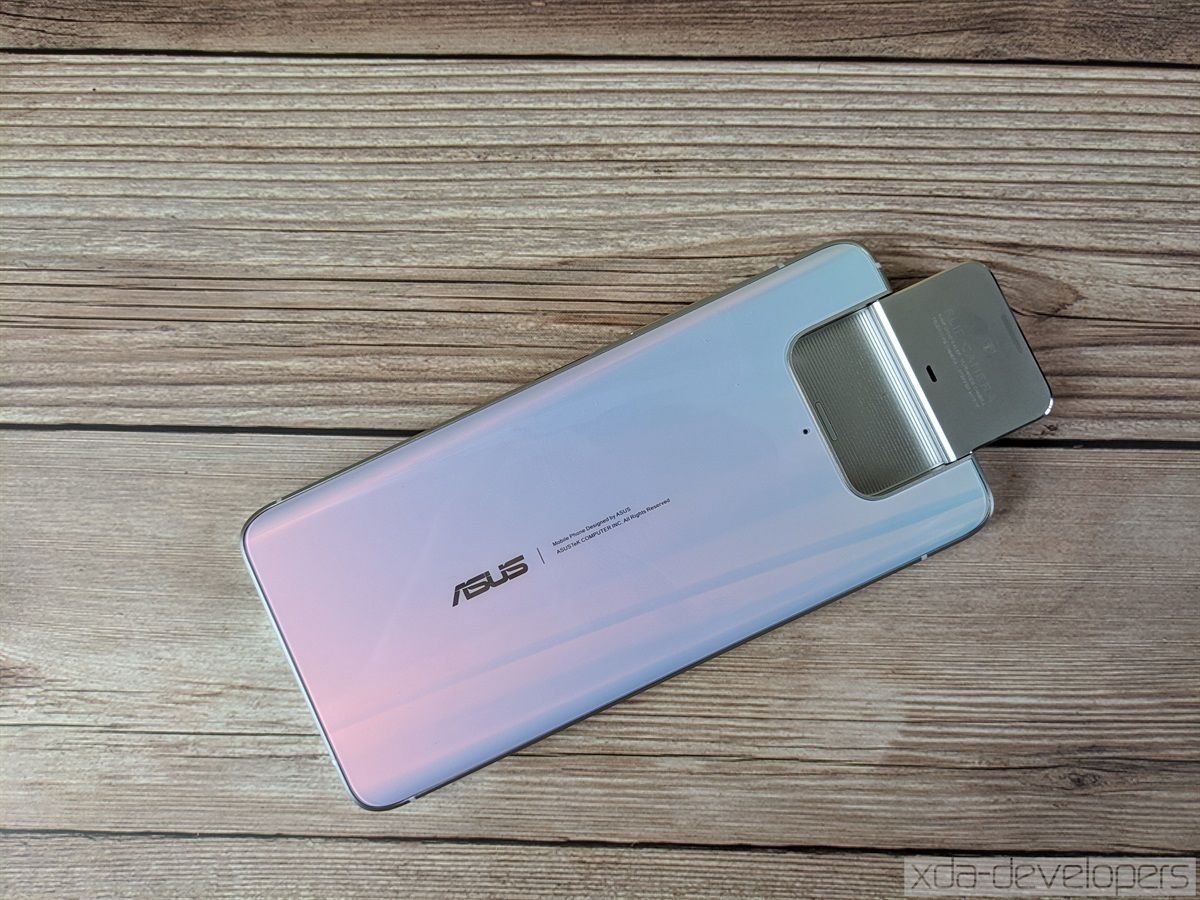

The device has a glass back with a layer of Gorilla Glass 3 for scratch resistance. ASUS sent me the ZenFone 7 Pro in its Pastel White color, which exudes a pink hue under lighting. The glass back isn’t frosted, so it can feel quite slippery and track smudges from your finger. The mid-frame is made of 6000 series aluminum alloy, giving the phone a more weighty and premium feeling than last year’s ZenFone 6. The Flip Camera housing is actually made of its own unique material, which we’ll get to in a bit.
The top of the phone is taken up almost entirely by the Flip Camera housing, though there is room for one microphone hole in the middle of an antenna band. The gap between the Flip Camera and the rest of the top is a hotbed for dust and particles, which may irk those of you who like to obsessively keep your phone clean. At the bottom, you’ll find a bottom-firing speaker (the earpiece speaker doubles as the secondary speaker), a USB Type-C port for data and charging (though sadly, no video output), a microphone, and an LED indicator. Honestly, I thought the placement of the LED indicator at the bottom was a tad odd at first, but it serves its purpose when my phone is lying face-up on a table. ASUS added an Always on Display mode to the ZenFone 7 Pro, so the lack of an LED indicator on the front isn’t that much of an issue, in my view.
The left side of the phone has the triple slot card tray, which is a rarity to find in smartphones these days. You can insert up to 2 nano SIM cards here as well as 1 microSD card slot to expand the storage capacity. Most phones (that aren’t sold in the U.S.) can only fit 2 nano SIM cards or 1 nano SIM card plus 1 microSD card (if you’re lucky), so to have the option to use 2 nano SIM cards and a microSD card means the ASUS ZenFone 7 Pro offers great versatility for frequent travelers. Only 1 of the 2 provisioned nano SIM cards can connect to 5G NR, though, while the other is relegated to 4G LTE; given the lack of 5G access in many areas, that isn’t really a big deal.
The rear is pretty clean save for the ASUS logo, some text about the copyright formality, a single microphone for the Nokia OZO-powered audio capturing features, and the Flip Camera module. There’s a curve near the edges to make the phone easier to hold, though it’s very subtle. The camera bump is pretty large, so the phone won’t rest flat on a table. Fortunately, the camera bump is centered and balanced, so the phone won’t wobble when you’re using it while it’s lying flat.

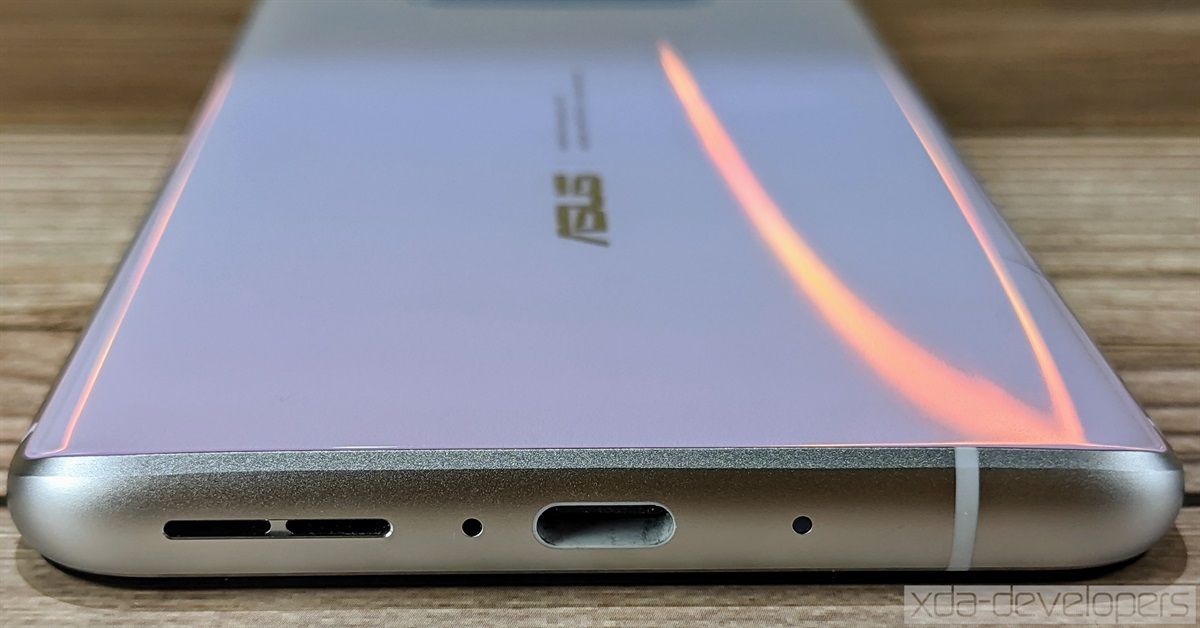
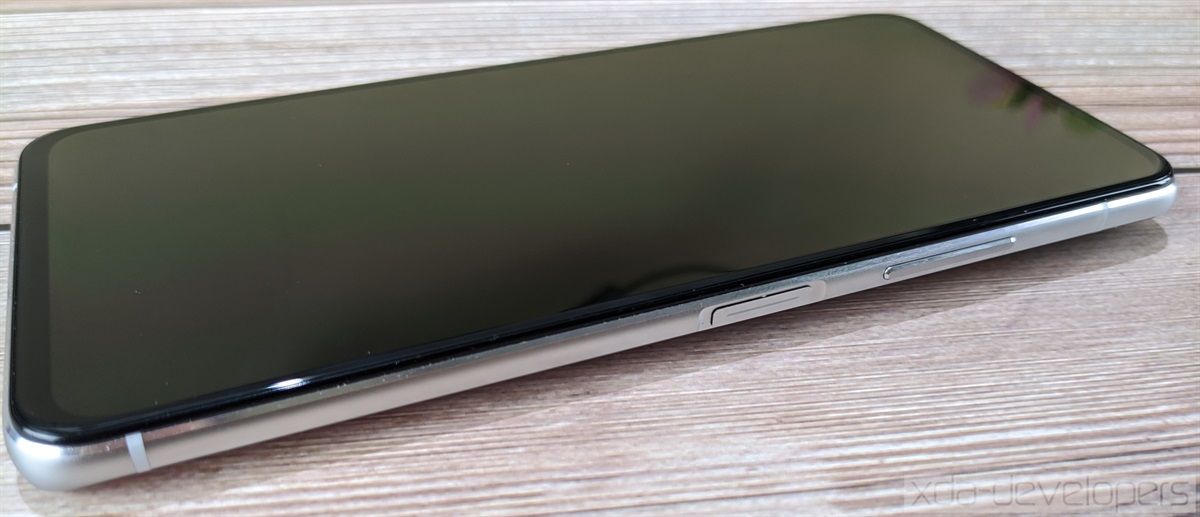



The right side of the ASUS ZenFone 7 Pro has the volume rocker and power button, which has triple duty as the fingerprint scanner and “Smart Key.” By consolidating the fingerprint scanner and Smart Key, which are located on the rear and upper right side of the ZenFone 6 respectively, into the power button, ASUS managed to simplify the design without sacrificing utility. The fingerprint scanner is quick and responsive, featuring Goodix‘s capacitive side-key technology. And with integrated Smart Key functionality, you can map an action to a double-tap or press and hold gesture, allowing you to quickly turn on the phone, unlock it, and launch an app or shortcut.
The Flip Camera has seen several improvements since its debut on the ZenFone 6. For starters, the material used to construct it, which ASUS says is liquid metal (metal alloys with an amorphous structure), has become easier for ASUS to process. The difficulty of processing this material is what caused shortages of the ZenFone 6, so hopefully, the ASUS ZenFone 7 Pro won’t have such big supply issues. The stepper motor is now marginally faster and smoother at moving the Flip Camera module, which means that finer and more accurate adjustments to the angle are now possible. More importantly, there’s a new angle sensor that allows for quickly deploying the camera to pre-defined angles that you can set up in the camera app. Lastly, the Flip Camera module is more durable this generation, with an I-shaped stepper motor design that provides nearly 2.2X more torque, an 18-layer FPC cable with 110 signal outputs providing twice the rated lifetime (up to 200,000 flips), and a stronger housing that can hold 40% more weight (up to 35kg) before breaking from bending.
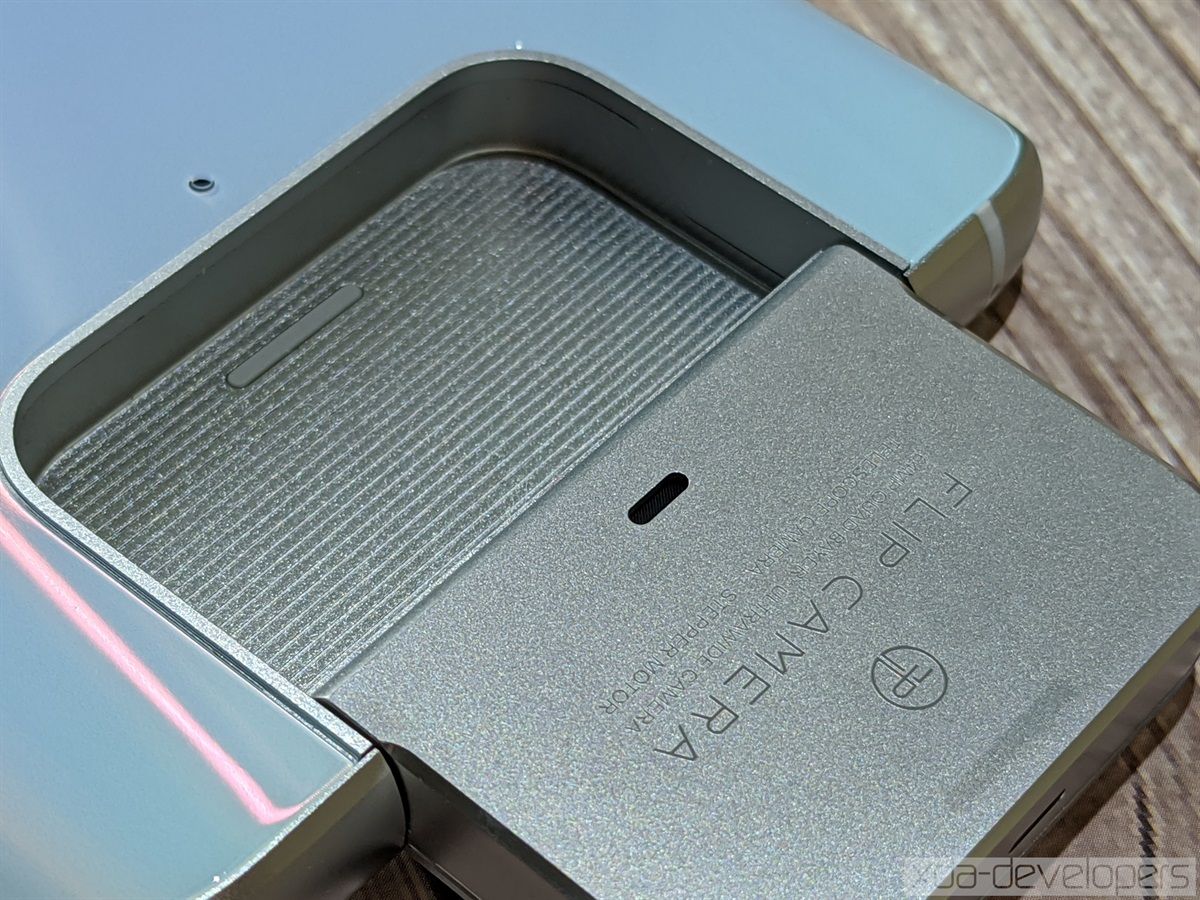
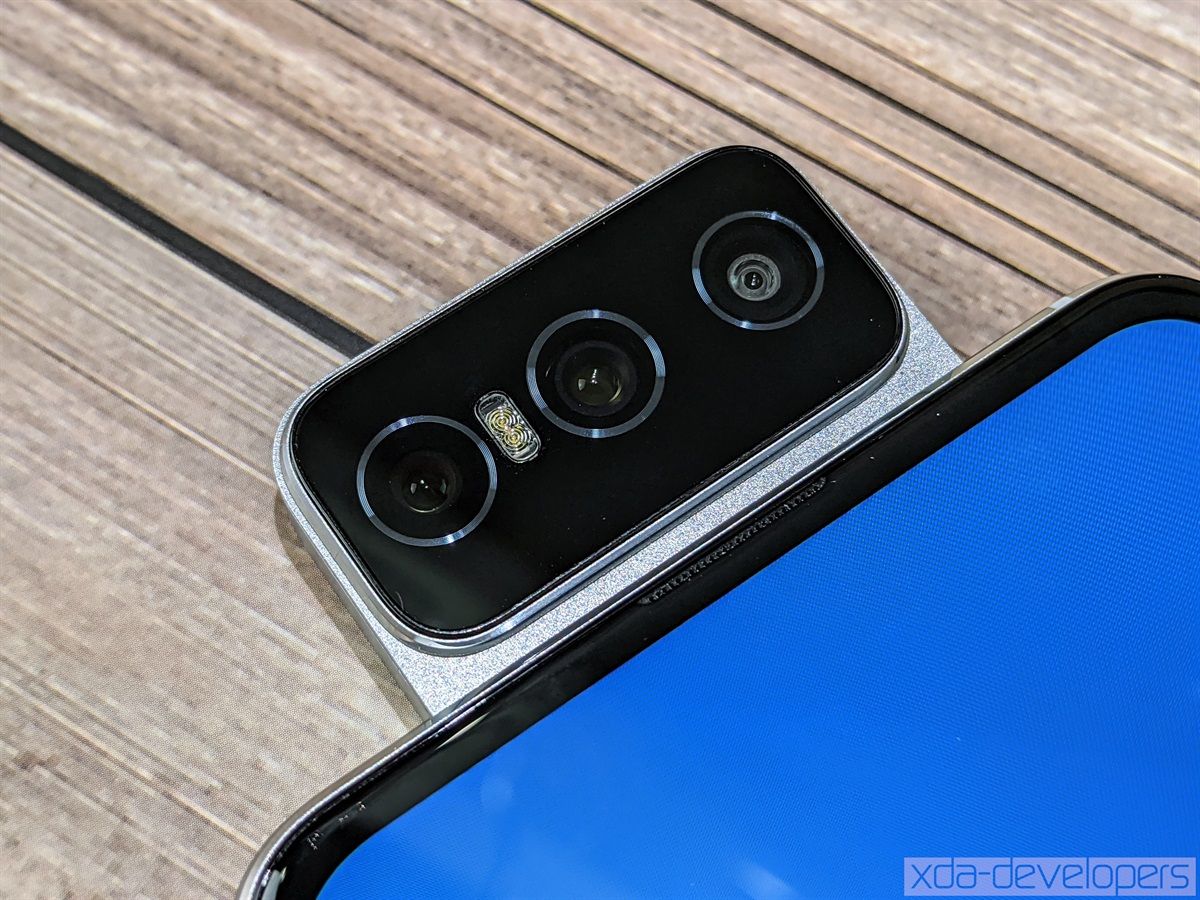
The stepper motor does make noise when it’s moving, but it’s not loud enough for anyone to hear unless they’re close by in a quiet room. You can add a sound effect to the Flip Camera movement in Settings > Sound & vibration > Flip camera sound, though this is disabled by default since it’s a bit tacky.
Here’s a demo of the Flip Camera movement on the ASUS ZenFone 7 Pro. In the video, I cycle through the 3 default camera angles (45°, 90°, and 135°), retract the camera, and then flip the camera using the manual motor control.
If you’re worried about the Flip Camera breaking, then you should know that ASUS added a G-sensor to detect when the ZenFone 7 Pro is falling so it can automatically retract the Flip Camera. If you’re just worried about the Flip Camera opening up when it shouldn’t, though, you can put the phone in the Active Case that comes in-the-box. This case has a latch that you can pull out to lock the Flip Camera in place. It’s also ruggedized so it has a nice, grippy feel, and it’s also as thick as the camera bump, making the phone level with a table if you’re worried about damaging the cameras.

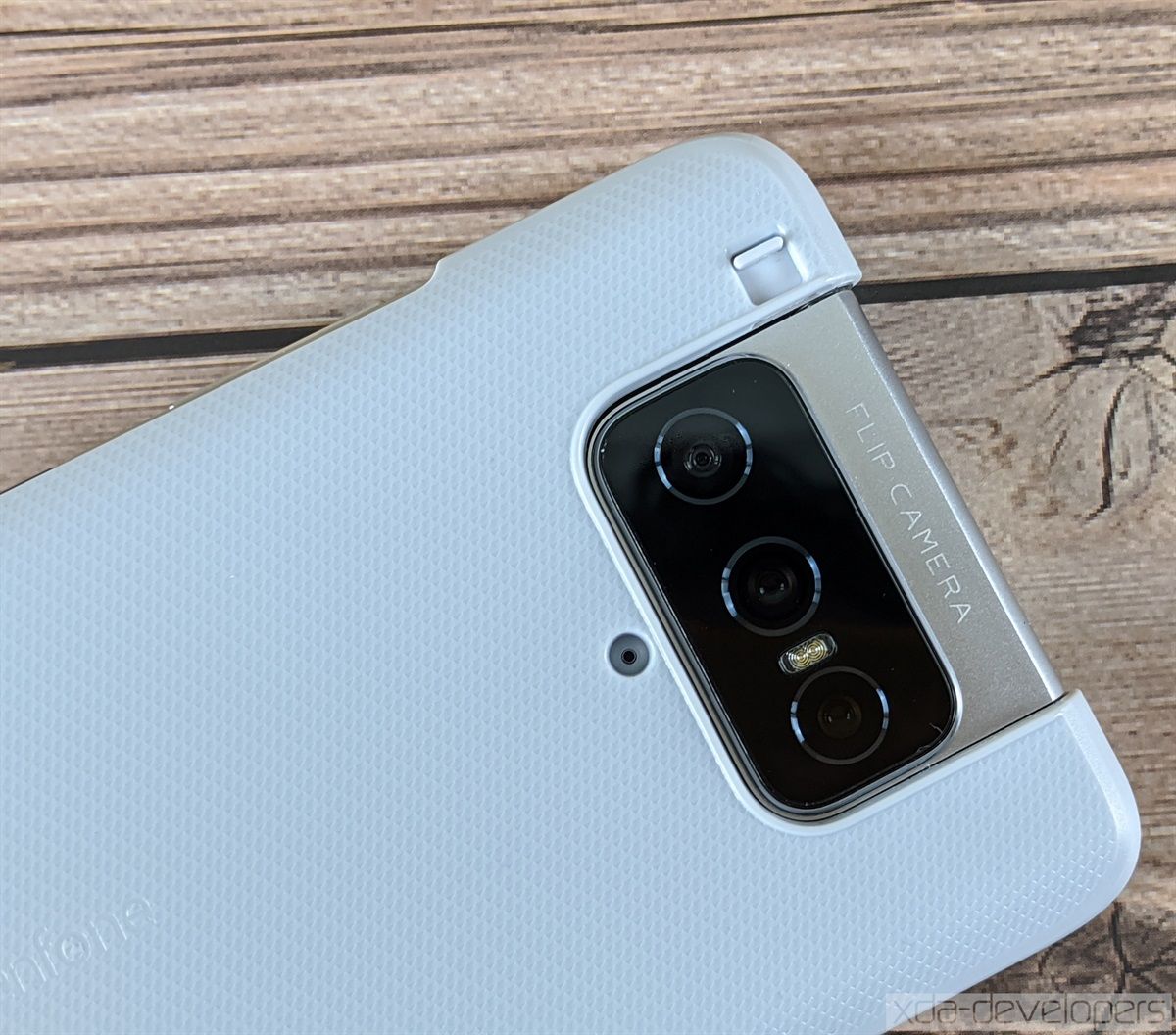
ASUS ZenFone 7 Pro: Camera Quality
The main benefit of having this Flip Camera module is that the rear cameras—which are almost always the best on any given smartphone—double as the front cameras. That means the ASUS ZenFone 7 Pro offers the most powerful front-facing camera hardware out of any smartphone in the market. How many other smartphones have a telephoto camera on the front? None. How many other smartphones can record at 8K resolution from the front? None. How many other phones can automatically take a panorama for you (let alone a wide-angle panorama), precisely angle the camera so you don’t have to awkwardly hold it, and seamlessly switch between recording video from the front and the rear? None.
I believe, therefore, that the ASUS ZenFone 7 Pro gives users the most versatility in how they want to take a photo or video than any other smartphone I can think of. Last year’s ZenFone 6 only had a dual camera setup comprised of a 48MP main and 13MP ultra wide-angle sensor, but this year ASUS upgraded it to a triple camera setup in the ZenFone 7 Pro. The primary image sensor is Sony’s 64MP IMX686 with an f/1.8 aperture lens and 2×1 on-chip-lens (OCL) PDAF. The secondary one is Sony’s 12MP IMX363 image sensor with an f/2.2 aperture, 113° field-of-view wide-angle lens and dual PDAF. The third camera is an 8MP image sensor with an f/2.4 aperture and 3X optical zoom lens, with up to 12X total zoom.
Images from the 64MP camera are pixel-binned down to 16MP resolution and are stabilized with OIS (only on the ZenFone 7 Pro and not the regular ZenFone 7). The telephoto camera is also housed in an OIS module, though again, OIS is only there for the ZenFone 7 Pro model. The ultra wide-angle camera can also do macro shots at 4cm distances with autofocus, and it’s also behind the HyperSteady feature, which combines the wider field-of-view with EIS to give a larger cropping canvas to compensate for shaking.
In terms of video, the ASUS ZenFone 7 Pro supports recording at up to 8K resolution at 30fps with EIS from the main camera, up to 1080p resolution at 60fps “HyperSteady” videos from the ultra wide-angle camera, and up to 1080p resolution at 30fps from the telephoto camera. The 3 microphones placed around the phone can boost audio capture quality, reduce wind noise, or provide directional recording though Nokia’s Audio 3D, Audio Focus, Audio Zoom, and Audio Windscreen OZO features. However, these must be manually enabled by the user.
Of course, it’s not all about the hardware, but the image tuning and camera software, too. Here’s a Google Photos album containing dozens of photos I capture from the ZenFone 7 Pro. I’ve included a few samples below, but I recommend taking a peek at the album anyway since the photos embedded below have been resized and compressed. Furthermore, I included some panorama samples in the album if you’re wondering what images taken by the auto-panorama feature look like.
ASUS ZenFone 7 Pro Camera Samples – Google Photos
Main Camera












Low-Light




Left: Regular photo. Right: Night mode photo.
Ultra Wide-Angle






Left: Ultra-wide angle photo. Right: Regular photo.
Macro




Telephoto












Left to right: 0.6X (ultra wide-angle), 1X (main), 3X (telephoto), 12X
Selfie




Left to right: 0.6X (ultra wide-angle), 1X (main), 1X portrait mode, 3X (telephoto)
There are some differences in white balance, color temperature, and exposure between the ultra wide-angle and main cameras, but the overall quality isn’t bad. I did notice a few out-of-focus/blurry spots near the far edges in some of the wide-angle photos, but I only noticed them when pixel peeping. The ultra wide-angle camera definitely serves its purpose well, though, adding a much larger field-of-view for selfies, super steady video recordings with the HyperSteady mode, and decent macro shots. The quality of the macro photos is a nice change of pace for me, in comparison to the low-resolution and poor-focusing macro cameras of the ROG Phone 3 and OnePlus Nord.
I’m mostly impressed by the sharpness of images from the telephoto camera. Images at 12X zoom are surprisingly usable when focusing on a single, mostly static subject, and OIS definitely helps to keep camera shake in check. There’s a noticeable difference in color science between the main and telephoto camera when there’s a sky or greenery in the background, but I don’t notice any major issues when zooming in on buildings, people, or animals.
Selfie camera quality is, as expected, excellent. Images are incredibly sharp from the main camera. Portrait mode applies the bokeh effect to varying degrees of success; I’ve noticed the person detection struggles when I’m wearing a mask. The blur effect and beauty mode can be modified by accessing them in the viewfinder. It’s quite eerie to zoom in on your face using the telephoto camera, so I only tried that twice.
I’ve taken a few low-light photos using the built-in Night Mode, though they’ve all been indoor low-light shots. Detail surrounding the subject is muddy, but the subject itself becomes much clearer with Night Mode enabled. ASUS says an upcoming software update will improve low-light photography, so I’m waiting for that update to arrive before taking more low-light photos.
The quality of video recordings is also good, save for in the HyperSteady mode. HyperSteady does significantly stabilize the video when moving, but significant detail is lost and the video looks blurry. My voice came out loud and clear in the videos with the wind filter feature turned on. Lastly, HDR and 8K video are overkill for social media and YouTube, but it’s nice to have these options when you’ve fixed your phone to record a certain spot.
Overall, I’m content with the camera and video quality of the ASUS ZenFone 7 Pro. If you pixel peep and stare at the sky a bunch, you’ll probably notice flaws in the color science, white balance, etc. However, I’m mostly happy with the quality of images and videos recorded from the ZenFone 7 Pro, especially since the phone allows me to capture photos and videos in ways that other devices simply cannot.
ASUS ZenFone 7 Pro: Display
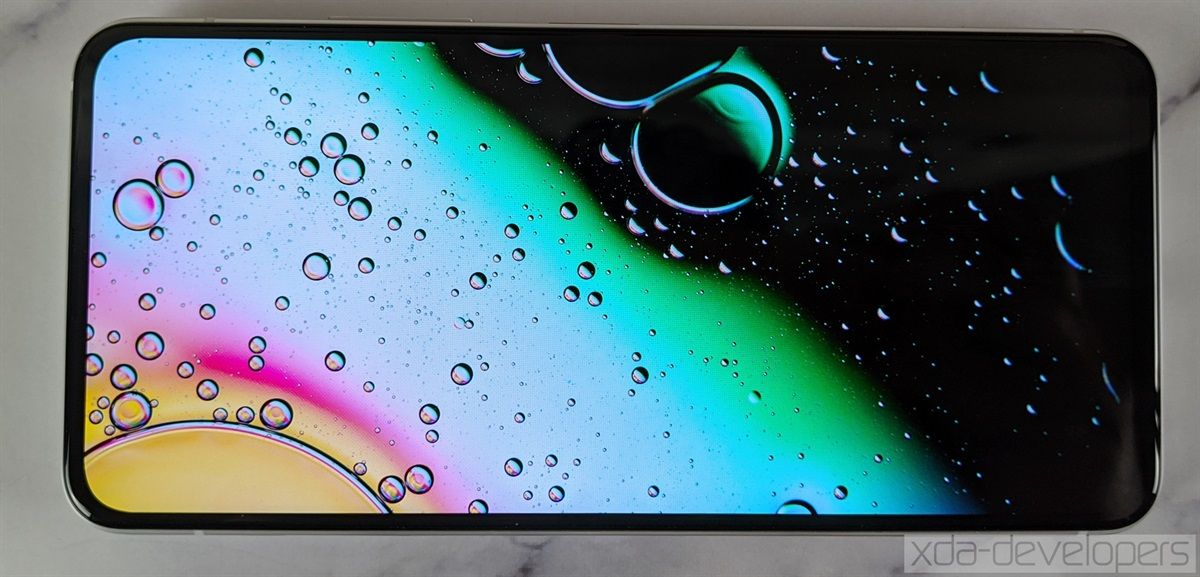
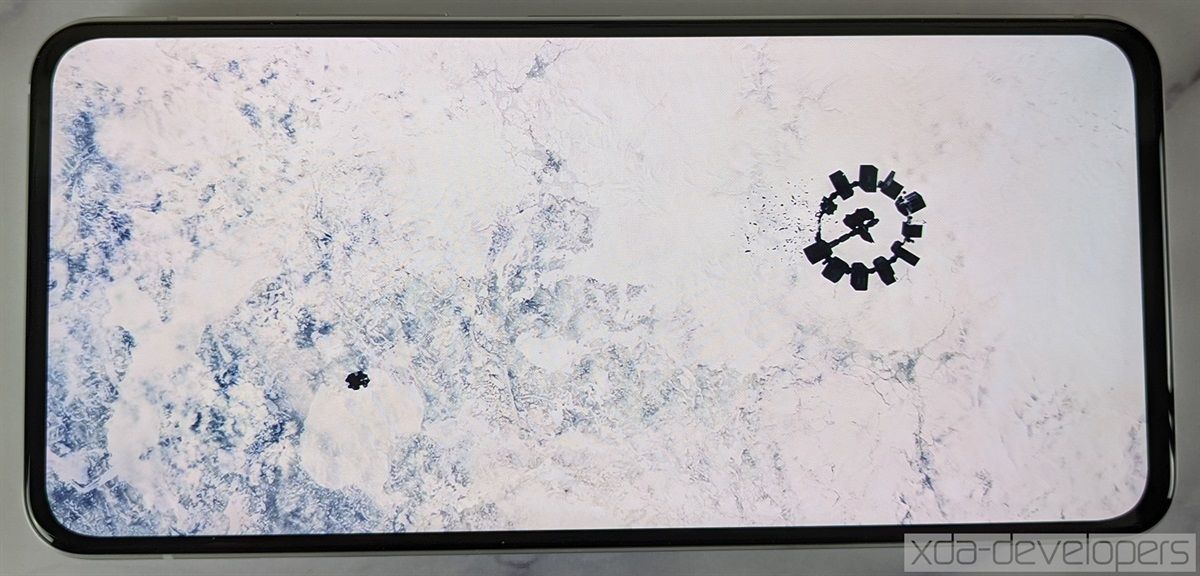
The ASUS ZenFone 7 series features a 6.67-inch Samsung AMOLED display with a 90Hz refresh rate, in contrast to the 6.4-inch LCD on the ZenFone 6 with a 60Hz refresh rate. Most users will see the shift from LCD to OLED as an upgrade, and I would agree. The much higher contrast ratio and wider color gamut make for a great viewing experience in HDR videos, such as with the movie Interstellar as shown above to the right. Even for non-HDR content, SDR-to-HDR tone mapping powered by Pixelworks’ Pro Software can enhance the viewing experience.
The brightness maxes out at 700 nits with High Brightness Mode (HBM) and 100% APL and 1,000 nits for HDR content. That’s plenty bright for most users and is bright enough for me to read outdoors, though I haven’t been doing much outdoor reading on my phone because of COVID-19. On the opposite end of the spectrum, the display can get fairly dim, making for a comfortable reading experience at night with Night Light turned on. And if you’re bothered by OLED flickering at low brightness, you can enable DC dimming to adjust the display brightness via traditional analog control rather than pulse-width modulation (PWM).
ASUS boasts a ΔE<1 color accuracy, though I’m not sure if that’s with the screen calibration set to the default, natural, cinematic, or standard mode. I don’t have the tools to verify the color accuracy, but I can tell with my naked eye that the color temperature is a tad bit too warm by default, at least compared to typical Samsung OLEDs. There is a slight blue shift at far angles, but I did not observe any rainbowing effect, which would have been indicative of a cheap polarizer. At low brightnesses, I did notice that darker gray backgrounds have a slight green tint, but only near the top of the screen. Grays have a slight reddish tint at mid brightnesses but seem to be displayed accurately at high brightnesses. I have not noticed any black crush (in a black saturation level test, I can distinguish down to 5) nor have I seen any smearing of blacks when scrolling at low brightnesses. Viewing HDR video with lots of dark backgrounds, such as in Interstellar’s docking scene, is enjoyable, even at low brightnesses.
The Full HD+ resolution is definitely lower than what you’ll find on premium flagships like the OPPO Find X2 Pro and OnePlus 8 Pro but is par for the course for most flagship smartphones. The 90Hz refresh rate, though, is a welcome upgrade from the ZenFone 6, and as I’ll explain in greater detail in the performance section, the ZenFone 7 Pro absolutely nails maintaining its target 90fps. There are also no oddities with how the refresh rate is handled, like on the ROG Phone 3 where the refresh rate is capped at 60Hz when the brightness falls below 20%. I have not noticed any errant refresh rate switches that would cause noticeable flickering from the changes in gamma calibrations. That being said, the ZenFone 7 Pro is like most other smartphones with a high refresh rate OLED display in that it doesn’t support variably switching its refresh rate. We can expect this tech to make its way to a future flagship smartphone from ASUS.



The ASUS ZenFone 7 Pro features an Always on Display mode with a couple of designs. The clock, date, and battery indicator all periodically move around the screen to minimize the chances of burn-in. For what it’s worth, I have not faced any problems with burn-in yet, not even temporary image retention, but I hope such problems do not arise for other users.
ASUS ZenFone 7 Pro: Battery Life & Charging
Battery Life
ASUS included a large 5,000mAh battery in the ZenFone 7 Pro, which is the same cell included in the ZenFone 6. The battery life isn’t as excellent as it was on the ZenFone 6, though, because of the larger, higher refresh rate display and more power-hungry, 5G-enabled Qualcomm Snapdragon 865. However, the ZenFone 7 Pro’s battery life is still a step above most other flagship smartphones with the Snapdragon 865. I get between 5.5-7.5 hours of screen-on-time with moderate usage consisting of watching videos on YouTube or Google Chrome, browsing social media including Reddit or Twitter, chatting on Telegram, Discord, WhatsApp, WeChat, Hangouts, and listening to music on Google Play Music or YouTube Music. I have good to excellent signal at home and also alternate (intentionally) between Wi-Fi and mobile data to gauge the battery drain from network standby.




My average screen-on-time isn’t a terribly useful metric since it depends on my personal usage. However, I would bet that the ZenFone 7 Pro will easily last a full day’s use for the majority of people, no matter what workload is thrown at it.
Except for hardcore gaming, of course, because you’ll only squeeze a few hours of juice out of the ZenFone 7 Pro when playing the most intensive games. The ZenFone 7 Pro is estimated to last 140.5 minutes, or about 2 hours and 21 minutes, if it continuously ran GFXBench’s Manhattan 3.1 benchmark at full brightness in a loop. Manhattan 3.1 is far more performance-intensive than the average mobile game and most users don’t keep the display at maximum brightness all the time, so consider 2 hours and 21 minutes to be the baseline battery life for gaming.
Charging

When your ZenFone 7 Pro runs low on power, you can use the included 30W USB-PD 3.0 PPS charger to top up the battery. Alternatively, you can also use a 30W ASUS HyperCharge adapter. Both charging methods take about 100-110 minutes to fully charge the device, though there’s a difference in how cool each charging method keeps the battery.


To maintain the long-term health of the battery, you can toggle slow charging in settings to limit the charging speed to a maximum 10W. You can also set a charging scheduler that charges the phone to a set percentage and then slowly charges the rest of the way once it’s near time for the alarm to go off. Lastly, you can also set a charging limit to keep the battery from constantly charging to full, which reduces battery capacity loss over hundreds of charging cycles. The charging limit can also be used as a passthrough charging solution when gaming, powering the device directly without degrading the battery.
ASUS ZenFone 7 Pro: Performance
Specs, Synthetic Benchmarks
The ASUS ZenFone 7 Pro features Qualcomm’s flagship Snapdragon 865 Plus SoC, whereas the regular ZenFone 7 features the standard Qualcomm Snapdragon 865. The Snapdragon 865 Plus features an overclocked Prime core @ 3.1 GHz and 10% faster graphics rendering in the Adreno 650 GPU, but is otherwise the same as the Snapdragon 865. The SoC is paired with 8GB of LPPDR5 RAM and 256GB of UFS 3.1 storage in the ZenFone 7 Pro, while the standard ZenFone 7 offers less RAM and storage.
Rather than redo the full gamut of synthetic benchmarks we’ve already done for numerous other Snapdragon 865-powered devices, including the Qualcomm Reference Device and the ASUS ROG Phone 3, I’m instead selectively running the synthetic benchmarks that I think will show interesting results.
First up, I ran PCMark’s Work 2.0 benchmark on the ASUS ZenFone 7 Pro to see how well it performs in day-to-day tasks. PCMark simulates everyday use cases such as browsing social media (Web Browsing 2.0), video editing (Video Editing), document and text editing (Writing 2.0), image editing (Photo Editing 2.0), and database management operations (Data Manipulation). For an in-depth explanation of all the subtests performed by PCMark’s Work 2.0 benchmark, refer to our article benchmarking the Snapdragon 865.

In PCMark, the ASUS ZenFone 7 Pro scored 13,826 points overall, about 1,352 points lower and 1,200 points higher than the ASUS ROG Phone 3 and Snapdragon 865 Reference Device respectively. The ROG Phone 3 benefits from having a performance-enhancing “X-mode” available, which at its level 3 setting sets the CPU and GPU frequencies to their maximum and disables DVFS of the SoC. The biggest difference between the ZenFone 7 Pro and ROG Phone 3 in this benchmark is the web browsing score, and the ROG Phone 3 benefits because its more demanding 144Hz refresh rate forces the scheduler and DVFS settings to be more tuned towards performance.

In CPU Throttling Test, the ASUS ZenFone 7 Pro seemingly demonstrates sustained CPU performance on par with the ASUS ROG Phone 3, as the former throttles to 88% of its max performance while the latter throttles to 87% of its max performance. However, the actual performance differs wildly between the two, with the ZenFone 7 Pro achieving lower peak and average performance over time. Few Android applications demand such sustained and peak CPU performance, though, so the gap between the two does not matter that much to most users. Still, this result shows that the performance between two devices with the same SoC can vary wildly, thanks to differences in scheduler and DVFS settings, the existence of performance-enhancing modes like X-mode, and different internal cooling systems.

Speaking of cooling, I ran GFXBench’s Manhattan 3.1 benchmark in a loop to test the sustained GPU performance. The ZenFone 7 Pro surprisingly renders more frames with each iteration of the benchmark compared to the ROG Phone 3, but the former gets much hotter than the latter. The battery temperature never topped 37° on the ROG Phone 3, whereas the battery temperature of the ASUS ZenFone 7 Pro quickly topped 40°C about 8 minutes into the loop and peaked at almost 47.5°C by the final few iterations. What this result means is that the ZenFone 7 Pro can get much hotter than the ROG Phone 3 while playing GPU-intensive games; phones built for gaming have fancy cooling systems for a reason!
App Launch Speed Test
Following the launch of the ZenFone 7 series, I saw comments from users on social media wondering why ASUS didn’t include the mid-range Snapdragon 765 to cut down on costs. People assume that SoCs have advanced to the point where there are only marginal differences in performance between the upper mid-tier and flagship-tier and that the average user won’t notice the difference. Keeping in mind that flagship-tier phones these days also feature faster RAM and storage units than upper mid-tier phones, we expect flagship phones like the ZenFone 7 Pro to noticeably outclass upper mid-tier phones like the OnePlus Nord when it comes to real-world tests like app launching speeds.
To measure this, we created a script that uses Android’s ActivityManager shell interface to time how long it takes for the main Activity of 12 popular applications to launch from a cold start (ie. when they’re not already in memory). These 12 applications are Google Chrome, Facebook, Gmail, Google Maps, Messages, Netflix, Google Photos, Google Play Store, Twitter, WhatsApp, XDA, and YouTube. We launch these 12 activities for several iterations (and kill each app between launches) to reduce the variance.



Left to right: ASUS ZenFone 7 Pro, OnePlus Nord, and Samsung Galaxy S20 (Snapdragon) App Launch Speeds
From these results, we can see that there’s a substantial difference in average app launch speeds between a flagship device like the ASUS ZenFone 7 Pro and an upper mid-tier device like the OnePlus Nord. When the difference is in the hundreds of milliseconds, nearing half a second, it may be noticeable to many users when comparing phones side-by-side. These raw results may not much to an average user when taking them at face value, but having faster app launches can really improve how fast and fluid a device feels. When you tap on an app’s icon in the launcher, you want the app to open up pretty much immediately without a delay between your tap and the app drawing its UI. OEMs use clever animations to make this app launch delay seem as low as possible, but there’s only so much that can be done when cold starting an app.
Notably, the ASUS ZenFone 7 Pro also loaded most apps more quickly than the Snapdragon Samsung Galaxy S20 5G, which suggests that ASUS did a great job at tuning the software since both devices feature basically the same hardware.
UI Stutter/Jank Test
After using the ROG Phone 3 with its 144Hz display, I thought I would struggle with the lower 90Hz refresh rate on the ASUS ZenFone 7 Pro. Fortunately, the ZenFone 7 Pro more than makes up for the difference in refresh rate by nailing the UI fluidity. I’ve almost never noticed a dropped frame—even in the notoriously laggy Twitter app which exhibits a ton of micro stuttering when scrolling through image and GIF-heavy feeds. The ZenFone 7 Pro feels faster than the ROG Phone 3 because it doesn’t miss its target framerate as often, although it’s obviously not as fluid because of the lower refresh rate. For a better comparison, the ZenFone 7 Pro feels substantially faster than the OnePlus Nord despite the latter also having a Full HD+ OLED panel at 90Hz.
Now, it’s not entirely fair to compare the ASUS ZenFone 7 Pro and the OnePlus Nord, as I’ve already shown how important the difference in SoCs is. The GPU in the Nord is the Adreno 620, which is far slower than the GPU in the ZenFone 7 Pro which is the Adreno 650. The GPU in the ROG Phone 3 and ZenFone 7 Pro are the same, though, so I was surprised to see any differences in fluidity between the two devices.
To quantify this difference, I ran a modified version of Google’s open-source JankBench benchmark. This benchmark simulates a handful of common tasks you’ll see in everyday apps, including scrolling through a ListView with text, scrolling through a ListView with images, scrolling through a low-hitrate text render view, scrolling through a high-hitrate text render view, inputting and editing text with the keyboard, repeating overdraws with cards, and uploading bitmaps. Our script records the draw time for each frame during the test and plots all the frames and their draw times along with several horizontal lines representing the target frame draw times for the 4 common display refresh rates (60Hz, 90Hz, 120Hz, and 144Hz.)


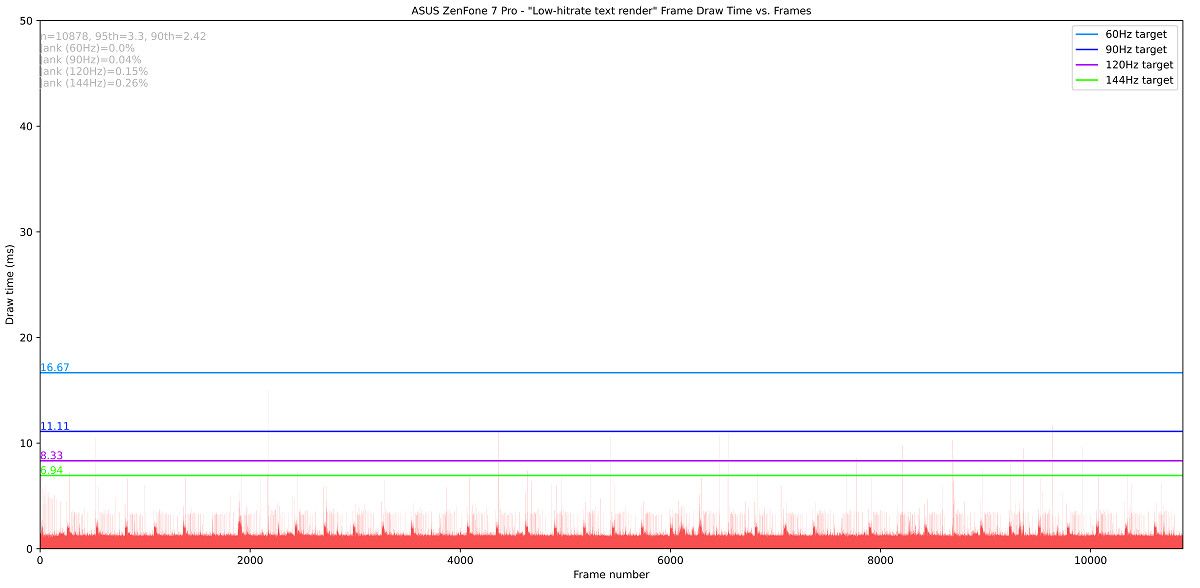
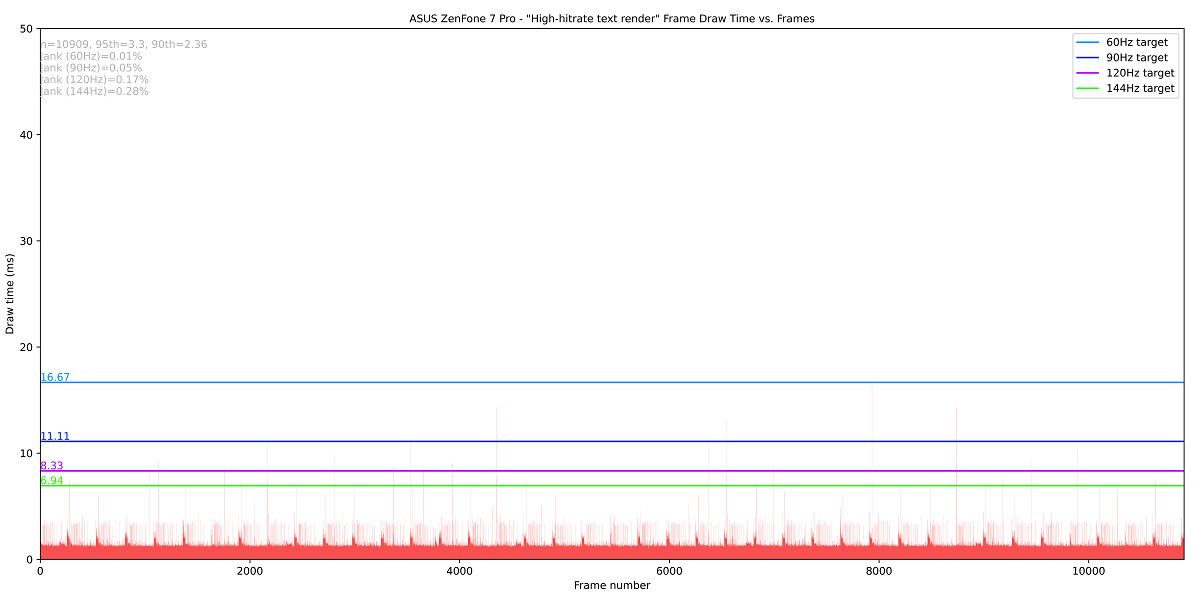


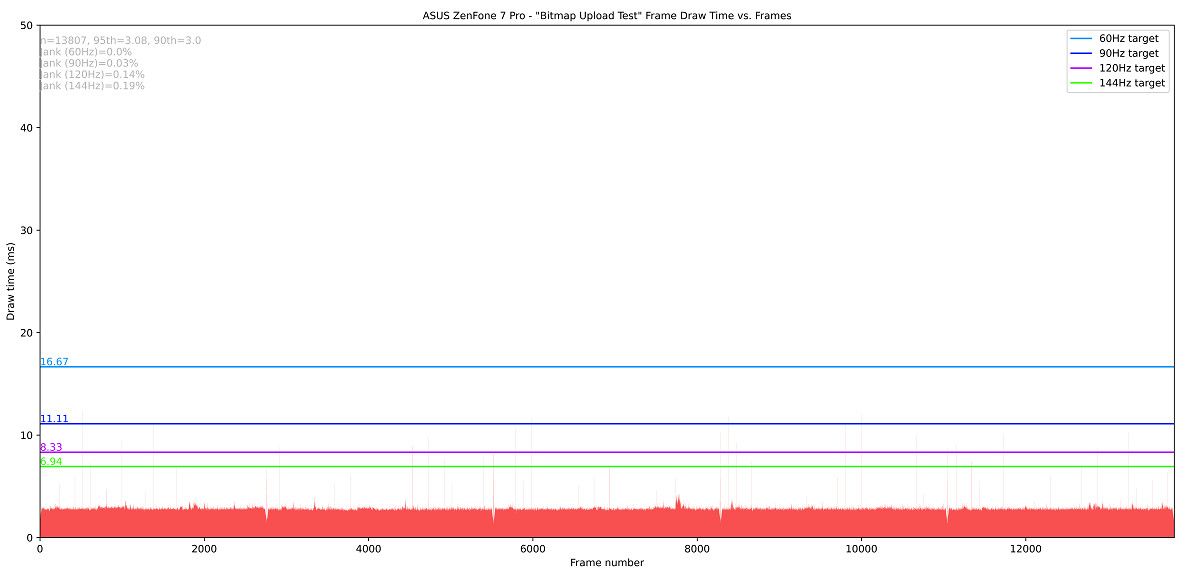



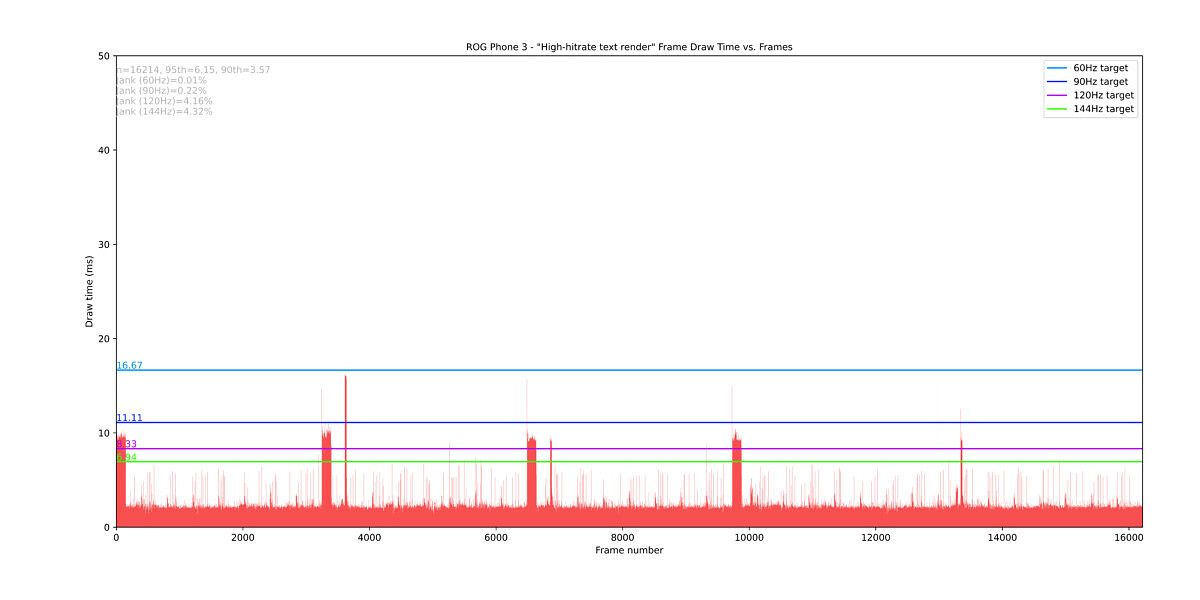
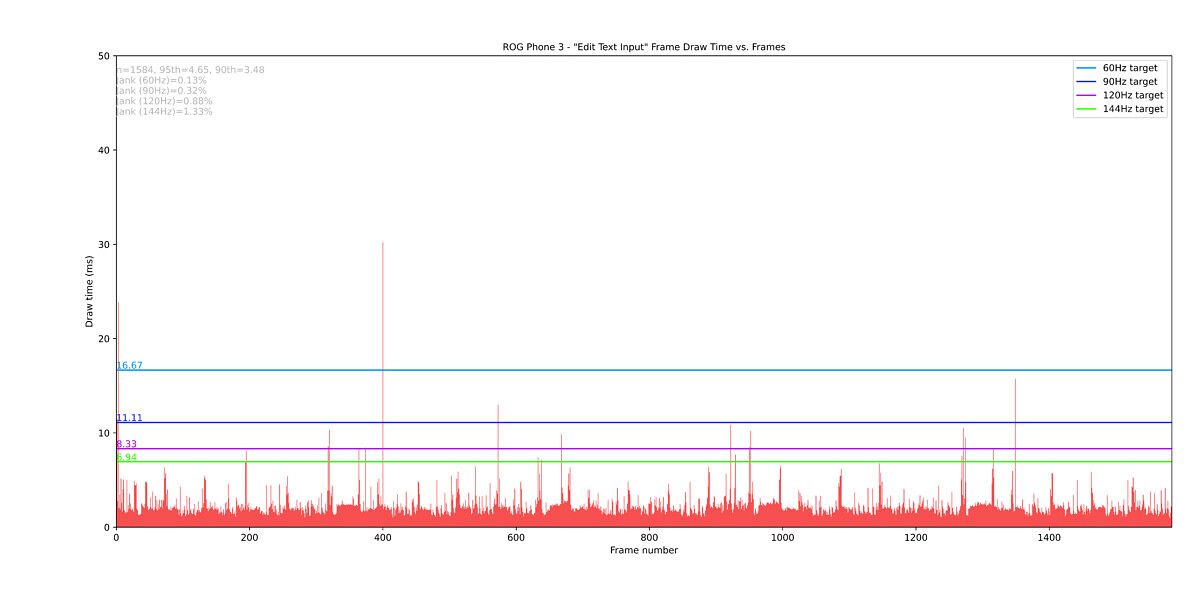


These results confirm what I’ve been seeing: the ASUS ZenFone 7 Pro almost never misses its target framerate. The bitmap test results for the ROG Phone 3 were a bit disappointing but reflect what I saw in image-heavy apps like Twitter. ASUS did tell us they made several software optimizations to improve the fluidity and responsiveness of the ZenFone 7 Pro and that the device is running on a newer codebase than the ROG Phone 3. We don’t know what is causing this discrepancy between the two devices, but whatever the case, ASUS did a stellar job at optimizing the UI fluidity of the ZenFone 7 Pro. The next step for ASUS should be to bring these performance optimizations over to the ROG Phone 3 and to work on further optimizing the animations in ZenUI 7 to make the device feel even more fluid. I’m reminded by how much effort Huawei put into optimizing the animations in EMUI, resulting in the Huawei P40 Pro feeling very nice to use despite its weaker Kirin 990 SoC.
Real-World Gaming
ASUS does not market the ZenFone 7 Pro as a gaming phone. It doesn’t have ultrasonic shoulder buttons, a cooling fan accessory, an air vent, etc. As such, it also lacks the Armoury Crate app for managing per-game settings. Still, the ZenFone 7 series features flagship-tier hardware and can handle nearly all of the same games as the ROG Phone 3. For example, I played 30 minutes of PUBG Mobile at the “HDR” quality setting and “Extreme” (60fps) framerate setting, and the ASUS ZenFone 7 Pro had no trouble maintaining 60fps during gameplay, as confirmed by the fact that the average fps was 59.81 with a MAD of 0.2.

Why we use MAD
We calculate MAD (Median Absolute Deviation) to replace Variance. Why? For different FPS ranges (i.e. 60 FPS vs. 144Hz games), Variance becomes less intuitive. The formula for Variance has errors (distances of samples from sample mean) grow quadratically, so for 144Hz games, the sum of errors quickly explode. Our MAD statistic is much simpler: We calculate the collection of absolute errors from the mean (not median, for our case), then grab the median of the collection. In the context of games, we can interpret this as “the middling value of all the FPS fluctuations”. As a quick example, if we have a sample of [49, 60, 51, 52, 60, 60, 59], the sample mean is 58.5. So the absolute errors become [9.5, 1.5, 7.5, 6.5, 1.5, 1.5, 0.5], and the median of that collection, our MAD value, is 1.5. This means that our game is running at 58.5 FPS on average, and half of frame fluctuations are equal to or lower than 1.5. Since the mean FPS in our samples is typically super close to the target FPS, then MAD gives us an approximate idea of what most framedrops look like.
There is one caveat to note, and it goes back to the results we saw from GFXBench: The ASUS ZenFone 7 Pro got noticeably hot to touch when playing PUBG Mobile at HDR/Extreme settings. I didn’t measure the skin temperature, but the device was getting uncomfortably hot for me. I noticed how hot it was getting while I was merely tapping and sliding on the screen! The Snapdragon 865 Plus is, of course, a powerful chipset that can bring you the best gameplay performance on Android, but without conservative tuning, a good cooling system, and a thermal design that not only dissipates heat away from the SoC and battery but away from where the user holds the device, the heat that’s generated can get quite uncomfortable. The ROG Phone 3 solves this problem with its air vent and AeroActive Cooler attachment, neither of which are available on the ZenFone 7 Pro.
If you only casually game on your phone, though, then you probably won’t face the issue I just described and shouldn’t be worried about the device getting too hot. The only time the ZenFone 7 Pro became uncomfortably hot for me was when I was playing PUBG Mobile for this review.
ASUS ZenFone 7 Pro: Audio
Audio is not a focal point of the ZenFone 7 Pro like it is on the ROG Phone 3. ASUS partnered with Swedish audio company Dirac to extensively tune every aspect of the audio quality on the ROG Phone 3; the ZenFone 7 series features no such audio tuning from Dirac. Like the ROG Phone 3, the ZenFone 7 lacks a 3.5mm audio jack. Personally, I’ve stopped using wired earphones/headphones (I use the Sony WH-1000XM3 and OnePlus Buds for Bluetooth audio everywhere except for on my desktop PC), so the lack of the 3.5mm headphone jack doesn’t bother me as much as it used to.
What does bother me, though, are the heavily imbalanced speakers on the ZenFone 7. The earpiece speaker is far quieter and produces audio that’s far lower quality than the bottom-firing speaker. The discrepancy between the two speakers is jarring to the point where I would rather there was a single bottom-firing speaker handling speaker output.
The speakers can get loud on their own but can get even louder with Outdoor mode enabled in Settings > Sound & vibration. As I just mentioned, I’m not a fan of the speaker quality, so don’t expect great-sounding audio from these speakers. The ROG Phone 3 truly shines in that department while the ZenFone 7 Pro is only passable.
ZenUI 7 – My New Favorite Non-Pixel Software
While OnePlus is now embracing a new design reminiscent of Samsung’s One UI, ASUS’s ZenUI still looks like Google’s flavor of Android. ZenUI 7 is based on Android 10 but adds loads of customization options and features on top without unnecessarily removing stock features. One of my biggest issues with other OEM skins is how they remove features that already exist in stock Android for no apparent reason, such as how OPPO’s ColorOS 7.1 unnecessarily messes with the behavior of notification dismissals, Do Not Disturb, suggested notification replies, and ADB access. With the exception of the aggressive background app management features that ASUS pushes users to enable—but thankfully aren’t enabled by default—there aren’t any changes to Android’s behavior that would annoy a Pixel fan.
There are too many features in ZenUI 7 for me to mention in this review, so let me just summarize some of the key features. For starters, I like the design of the camera app, for the most part. The shutter button serves multiple purposes; you can tap to take a photo, tap and hold to record a short video, swipe right to take photos in burst, or swipe up to start a timer. The camera swap button also has multiple functions; a single tap flips or retracts the camera while a swipe up or down lets you control the movement of the camera. Even the volume keys have been mapped to adjust the Flip Camera’s position! For quick angle adjustments, you can tap the Flip Camera icon in the viewfinder to choose from 3 angles; these angles can be adjusted in Settings. If you’re using a third-party camera app, a button will appear in the navigation bar that lets you flip or adjust the camera angle manually. Some of the other features that I like about ZenUI 7’s camera app include the intuitive zoom level adjustment and the seamless and quick transition between camera modes.
Smart Key customization is a feature that I mentioned in the Design section of this review, and it basically lets you customize what happens when you double-tap or press and hold the power button. Since the power button also doubles as a fingerprint scanner, your actions will always be triggered if you use a registered finger to tap the button, even if the phone is locked. Available actions include opening the Google Assistant, launching any ASUS system app or app of your choice, toggling various system settings, or launching one of many shortcuts available for the apps you have installed on your device.



Another key feature of ZenUI 7 is improved one-handed support. ASUS hasn’t redesigned the entirety of ZenUI to be more one-handed friendly, but they have added a toggle that shifts the Quick Settings layout, as shown below. They also offer an actual one-handed/reachability-like mode that you can activate from a Quick Settings tile, or if you have the option enabled, by double-tapping the home button. I don’t recommend enabling the double-tap home button shortcut for one-handed mode, though, because it introduces a noticeable delay to home button presses.



ASUS has also included various Always on Display clock styles, font styles, accent color options, icon shapes, power menu styles, and more in ZenUI 7.







UI customization features in ZenUI 7
As briefly outlined in the Charging section, ZenUI 7 offers a handful of battery management features to improve the battery longevity. Shown below are those settings screens as well as screens for customizing the battery mode. The high-performance mode stands out from the rest of the options here, as it raises the thermal limit and keeps the CPU frequencies at their ceiling.





Battery management features in ZenUI 7
Here are the various sound/audio-related options in ZenUI 7, including the settings screens for customizing screenshots and screen recordings. The ability to unlink the ringtone/notification volume and smart ringtone feature are two underrated features, though they aren’t new to ZenUI in ZenUI 7.





Various sound-related features in ZenUI 7
And here are some of the remaining settings pages. Game Genie lets you toggle various settings, free up memory, block unwanted distractions, and show real-time information while gaming; Twin Apps lets you duplicate select messaging and social media apps so you can sign in on a secondary account; Safeguard lets you set up an emergency SOS; OptiFlex optimizes memory use based on your actual app usage; and Gestures help you quickly launch apps, control music, answer phone calls, mute phone calls, check notifications, and more.






Miscellaneous features
There are still tons of features that I haven’t mentioned yet. For instance, ZenUI 7 extends Android’s notification snoozing feature by letting you actually schedule an alert rather than choosing from one of 4 options, the default dialer app has a built-in call recorder, and you can take scrolling screenshots. The more and more I use ZenUI, the more I enjoy using it. It still needs more polishing in a few ways, namely by better organizing various submenus and toggles, but I’m pretty confident in saying that ZenUI is now my second favorite Android experience after Google’s Pixel software.
(If you have trouble getting notifications to show up on time in ZenUI 7, I recommend you check the following:
- Settings > Battery > Detect battery-draining apps > Uncheck “Detect & stop”
- Settings > Battery > Auto-start manager > Make sure the apps you want to have running in the background are checked
- Settings > Battery > Uncheck “Hibernate apps”)
Conclusion – The ASUS ZenFone 7 Pro is my New Favorite Phone of 2020
While most OEMs have shifted to using either hole-punch displays or stuck with notches, ASUS decided to keep its motorized Flip Camera design, which was already a niche design in 2019. I think that was a brilliant decision to make as it’s the best stop-gap solution until under-display camera tech advances even further next year. The Flip Camera allows for the ASUS ZenFone 7 Pro to have a full-screen display without compromising on the selfie camera quality. But on top of that, ASUS added an automatic panorama feature, a motion tracking mode, a quick angle sensor, and more to improve the utility of the Flip Camera. The ZenFone 7 Pro’s gimmick became one of its main selling points. On the flip side (pun intended), this design made the ZenFone 7 Pro thicker, heavier, and less resistant to water.
The 6.67-inch, Samsung-made AMOLED panel at Full HD+ resolution and 90Hz refresh rate provides an enjoyable viewing experience. The color temperature is a bit warm and there are a few uniformity issues at low brightnesses, but I’ve had no complaints watching videos or browsing social media on the phone. The ZenFone 7 does a stellar job at maintaining its target 90Hz refresh rate, better than any other phone I’ve tested, and the Qualcomm Snapdragon 865 Plus, 8GB of LPDDR5 RAM, and 256GB of UFS 3.1 internal storage make for fast app loading speeds, minimal frame drops in day-to-day use, and excellent gaming performance. The phone can run a bit hot when playing graphically demanding games, so I recommend keeping the settings down if you want to extend your playtime. Fortunately, the massive 5,000mAh battery and conservative 30W charging means the ZenFone 7 Pro will last long on a single charge and also retain much of its battery capacity a few years down the line, though if you’re worried about battery longevity, ASUS offers several battery management features to extend the battery’s lifecycle.
The dual speakers are serviceable, though the imbalance between the two is very noticeable, with the bottom-firing one being much louder and clearer than the earpiece speaker. The lack of a 3.5mm audio jack is disappointing but not surprising these days. Fortunately, ASUS retained the triple card slot, so you can insert 2 nano SIM cards as well as a micro SD card.
ZenUI is one of my favorite Android experiences, and it’s gotten even better in ZenUI 7 based on Android 10. ASUS builds on top of Google’s Android 10 UI and adds loads of customizations that you never knew you wanted without taking away anything you’re used to. The ZenFone 7 Pro will get an update to Android 11, though ASUS is still trying to prove itself when it comes to providing long-term software support. They’ve gotten a lot better at software updates since revamping their smartphone strategy to cater to power users and enthusiasts, but we’ll have to wait and see how quickly they roll out Android 11 and if they can commit to delivering Android 12.
You can buy the ASUS ZenFone 7 and ASUS ZenFone 7 Pro in Taiwan and Europe. Neither phone will be available in the U.S., sadly. The pricing is as follows for Taiwan and Europe:
- ASUS ZenFone 7 (6GB + 128GB):
- Taiwan: NT$21,990
- Europe: €699
- ASUS ZenFone 7 Pro:
- Taiwan: NT$27,990
- Europe: €799
Other flagship devices that are close in price to the ZenFone 7 Pro include the 12+ 256 variant of theBlack Shark 3 Pro, the 8+ 256 variant of the ASUS ROG Phone 3, the 12 + 256 variant of the Realme X50 Pro, the 8 + 256 variant Xiaomi Mi 10, and the 12+ 256 variant OnePlus 8. We’ve reviewed each of these devices except for the Black Shark 3 Pro if you’re interested in comparing them. If you plan to pick up the ZenFone 7 or the ZenFone 7 Pro, visit ASUS’s website for your region and join the XDA forums linked below:
ASUS ZenFone 7 Forums ||| ASUS ZenFone 7 Pro Forums
The post ASUS ZenFone 7 Pro Review – A Flipping Fantastic Flagship Smartphone appeared first on xda-developers.
from xda-developers https://ift.tt/2QF2XXF
via IFTTT
No comments:
Post a Comment